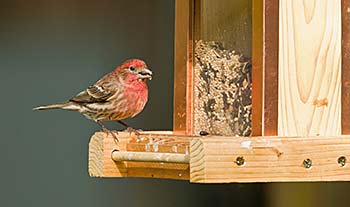Songbird diseases encountered at bird feeders
Dirty backyard bird feeders can spread songbird diseases

Feeding birds is a popular hobby and a great way to enjoy and appreciate wildlife at home. Dirty home bird feeders are also a way that avian diseases can spread.
Clean feeders once per week using a bleach solution (one part bleach to nine parts water). Rinse thoroughly, allow feeders to dry before refilling, and remove waste grains from the ground below the feeders. If a die-off has occurred, use stronger solution (one part bleach to three parts water), clean more frequently (every one to three days), and remove waste grains daily. Also, consider discontinuation of feeding for seven to 10 days. Watering stations (bird baths) should receive fresh water daily and be cleaned and disinfected weekly.
Common bird ailments
Tuberculosis: (bacterial, year-round) — Songbirds are highly susceptible
- Signs: Emaciated, weak and lethargic, possible diarrhea, lameness or ruffled appearance, possible pox-like lesions, but may exhibit no signs or lesions
- Control: Clean and disinfect feeding, watering areas
Salmonellosis: (bacterial, winter and spring at feeders, year-round near water) — Frequent in songbirds
- Signs: Rapid death, weak, drowsy, depression and diarrhea, vent and eye discharge, convulsions
- Control: Remove waste grains, clean and disinfect feeders, in event of die-off consider suspending feeding for a few weeks and cleaning feeders with strong disinfectant
Avian pox: (Viral, usually fall and winter) — Frequent in songbirds
- Signs: Wart-like growths on featherless areas (feet, legs, base of beak, eye margins), may exhibit difficulty breathing
- Control: Remove waste grain, clean and disinfect feeders frequently (at least every week). Infected birds may survive if nutritional intake is maintained and they are not re-infected
Chlamydiosis: (Bacterial, year-round) — Infrequent in songbirds; common in doves and pigeons
- Signs: Stops eating, weak, discharge around eyes and nose, huddle motionless in fixed position, diarrhea gray or rusty
- Control: Often becomes airborne in dry dusty environment, spray area with water and disinfectant prior to removing waste grain, clean and disinfect feeders
Conjunctivitis: (Bacterial, year-round) — Primarily known from house finches, but may infect other songbirds
- Signs: Partial blindness, disoriented, reckless flight, reluctance to escape predators, lesions around eyes and nasal passage, nasal exudates
- Control: Remove waste grain, clean and disinfect feeders regularly (every week)
Trichomoniasis: (Virulent protozoan, year-round but mostly late spring, summer, fall) — Infrequent in songbirds; doves and pigeons are highly susceptible
- Signs: Birds may appear ruffled, emaciated, and listless, cheesy yellow lesions possible around beak or eyes and face may appear puffy
- Control: Remove waste grain, clean and disinfect feeders and watering stations regularly (every week)
Aspergillosis: (Fungal, year-round) — Occasional in songbirds
- Signs: Emaciation, difficulty breathing, frequently gapes and gasps for breath, possible wing droop, ruffled appearance, often too weak to attempt escape
- Control: Mold grows in feed, straw and warm rotting vegetative materials, remove waste grain and discourage birds from composts
Cholera: (Bacterial, year-round) — Infrequent in songbirds
- Signs: Usually large die-offs, individuals lethargic, convulsions, toss head back, erratic behavior, some discharge-nose mouth and vent, rapid death
- Control: Use gloves, remove bodies and minimize spread of body fluids (place in plastic bags immediately), discourage birds from using area, remove waste grain, clean and disinfect feeders
Botulism: (Bacterial, July through September) — Rare in songbirds
- Signs: Usually large die-offs, loss of flight, paralysis of legs, paralysis of inner eyelid and neck
- Control: Remove carcasses, remove or renew water supply
Lead: (Contaminant, year-round) — Rare in songbirds, but can be frequent in raptors
- Signs: Weak flight, reluctance to fly, wing droop, discharge from bill, yellow-green diarrhea
- Control: This is usually not a problem generated by feeders, but may be exhibited by birds of prey feeding at feeders, however, feeders should not be painted with lead-based paints
Other sources of bird mortality
Collisions: Building window strikes account for millions of bird deaths each year. Birds that may have collided with a window of your home will often be found on the ground below the window and behave dazed, disoriented, lethargic and/or dead. Collisions with cars and wind turbine rotors are also sources of bird mortality.
Electrocution: Strikes at high-tension transmission and distribution power lines
Poisoning: Oil spills, pesticides
Domestic cats: Domestic cats kill billions of birds each year.

